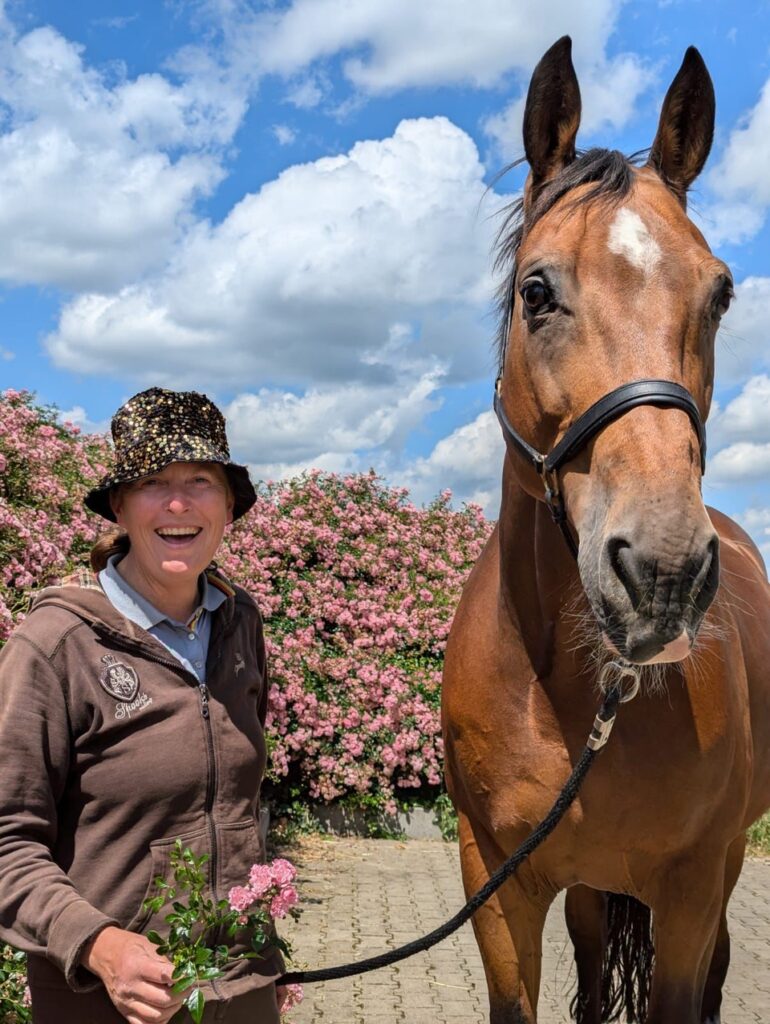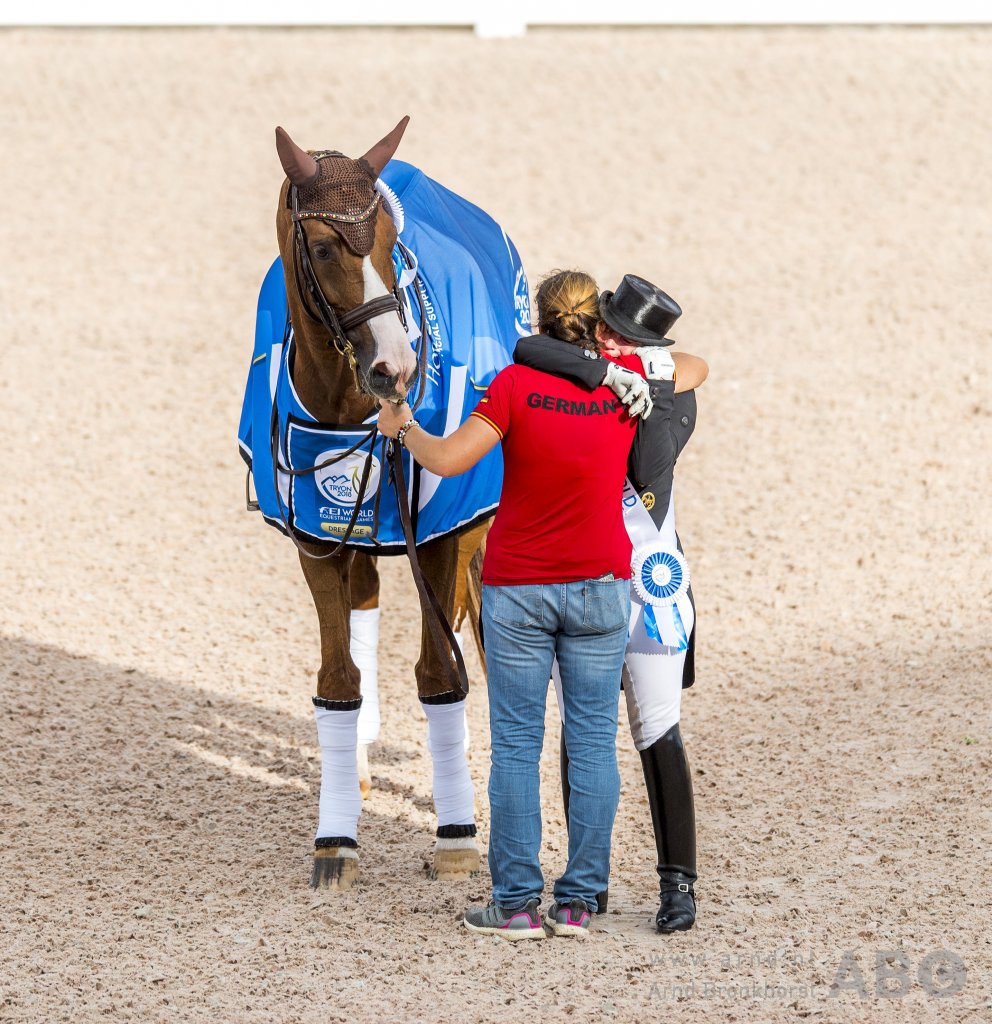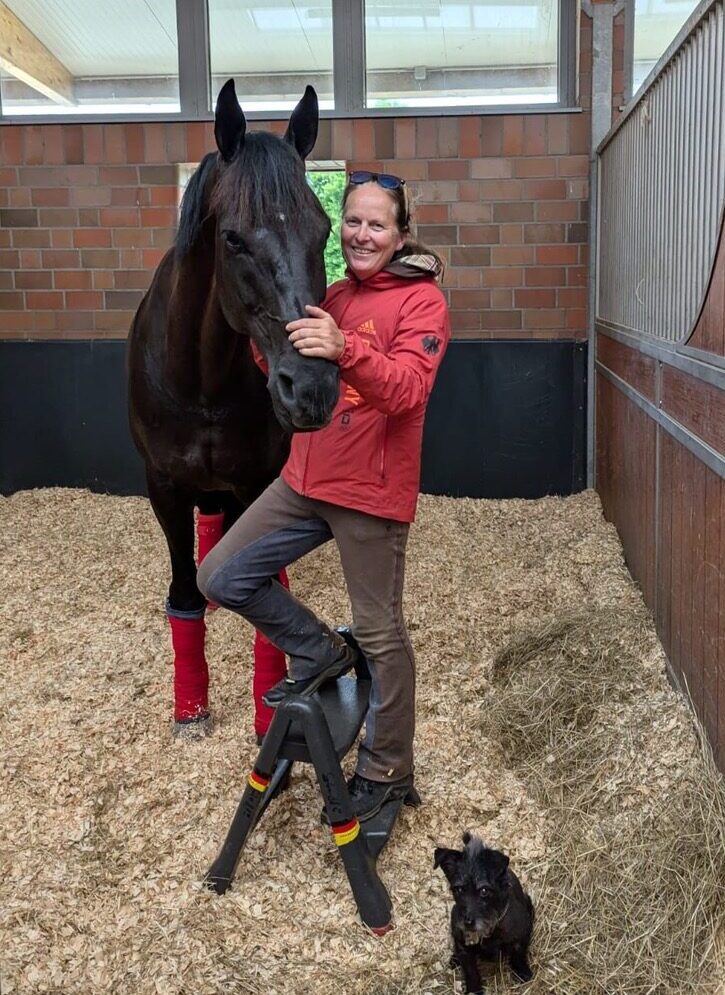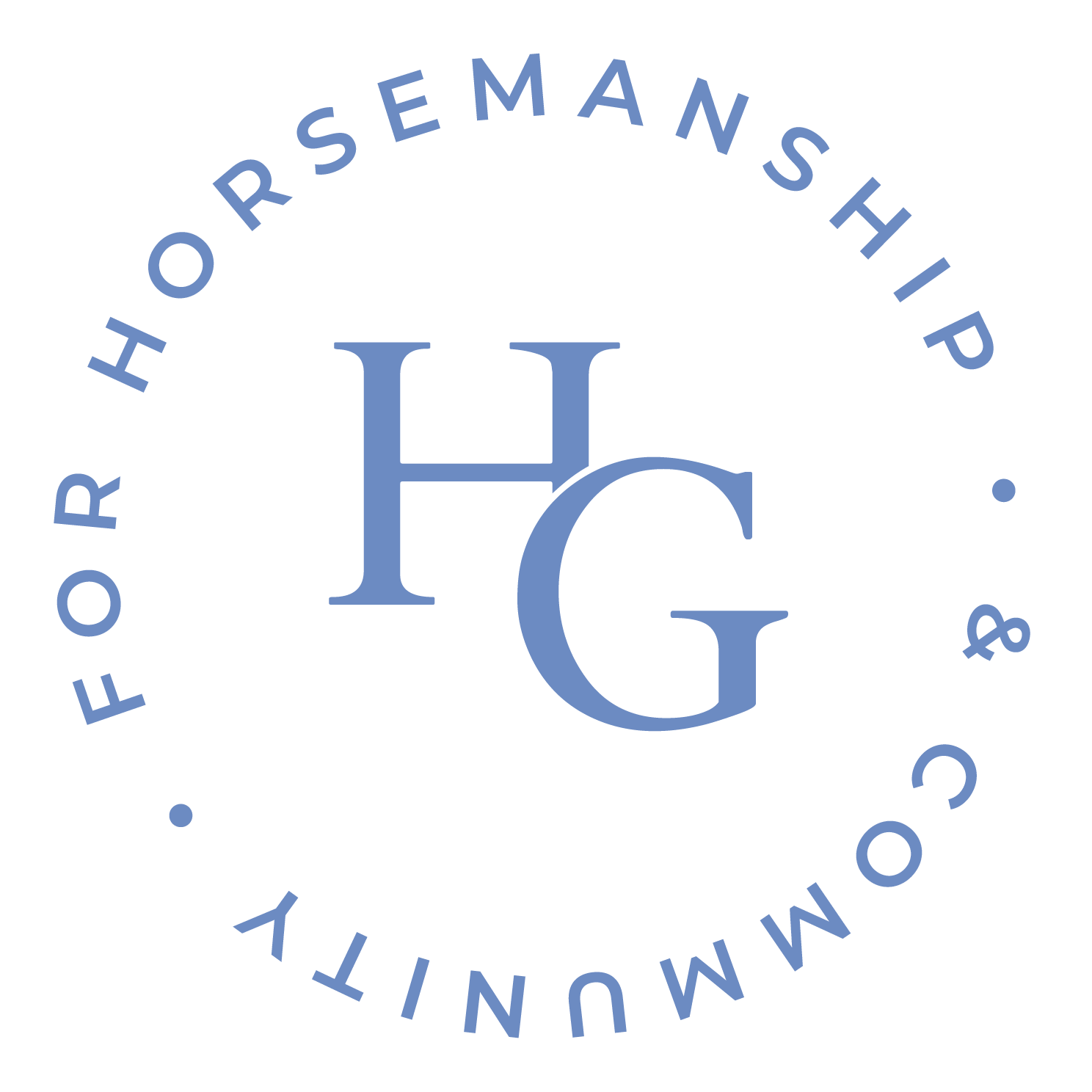Steffi Wiegard (54) has almost 40 years of grooming experience. She has been German dressage icon Isabell Werth’s (she’s won 49 gold medals between the Olympic Games, FEI World Equestrian Games, FEI World Cup Final and FEI European Championships – and those are just the golds) right-hand woman for 12 years.
More than just a groom, Wiegard plays a crucial role on Werth’s team. Despite working only four days a week for Werth, Wiegard dedicates her holidays to attending shows like CHIO Aachen (Germany), which often fall outside her regular workdays at her office job in Münster, Germany. For three days a week she works in the office of Hornbach, one of the leading DIY-store chains in Germany, and then the remaining days she works for Werth, who is based in Rheinberg, Germany.
Wiegard and Werth are just coming off a successful CHIO Aachen where Werth and Wendy de Fontaine took home top honors in the Grand Prix CDIO5* (the Prize of Family Tesch), Grand Prix Special CDIO5* (the MEGGLE-Prize) and the Grand Prix Freestyle CDIO5* (the Lindt-Prize), with DSP Quantaz taking second in the Grand Prix CDI4* and the Grand Prix Special CDI4*.
You started grooming when you were 16. What makes grooming horses so special for you?
Regarding my age I would like to say that the groom of Therese Nilshagen, Sebastian Ulrich, calls me the oldest dressage showgroom of the world. I believe this is true. He says this every time he sees me, and I enjoy this. My job is wonderful, emotional and fun. The grooms have their own small family, and I really like to hang out with the grooms of the show jumping riders. Their barbecues are always a highlight for me.

Sometimes I can’t even explain why I love this job so much. But the bond with a horse and what they give back to you is incredible. That’s what always motivates me. The horses give their all, and so do we. I’ve always enjoyed working with animals, especially horses. It’s difficult to put into words, but the connection with the horse really motivates me. It is like a vital essence for me. I have enjoyed doing it my entire life.
You started with grooming for one of the best riders, Reiner Klimke. Do you remember how you handled all these new experiences?
Yes, I can remember it well. At that time, Reiner Klimke’s groom was Claudia Rosner. She took me under her wing and, so to speak, raised me in the equestrian world. I owe her an incredible amount, and she always looked out for me. She took me to competitions and was essentially my “competition mom.” Through her, I learned a lot and grew into the competition life.
I believe it was the perfect combination. It wasn’t from zero to a 100. At home with Klimke, I had already observed a lot, and then I was allowed to accompany them to competitions. It was already a highlight to lead a horse. That’s how I grew up. Then came the point where Claudia Rosner started to retire, and I took over for Michael Klimke. Thanks to Claudia, I became very meticulous in my work. That’s how I learned that you have to be meticulous and precise. I had grooms around me at shows that were willing to help. For example, the groom of Ludger Beerbaum, Marie Johnson, was always helpful. If I had a question, she always helped.
What were important things that you have learned from Claudia Rosner?
There are so many aspects to it, such as sweeping properly and leading and grooming the horses correctly. Also, learning how to take care of the horses. The horse always comes first. It’s not just about saying, “I’m going to a party now;” that doesn’t exist in this job. That’s how I still do it today.
When we connect “old” to “new” what would you like to say to grooms who are starting new in this job?
They need to understand that they have to be there for the horse 24/7. This should not be underestimated. We also have a difficult rhythm. Sometimes, you travel overnight to a competition, arrive in the morning, and then it continues immediately. You might be tired, but you always have to be there for the horse. The horse is the top priority. We are entrusted with horses that don’t just cost €5 but significantly more. Everyone relies on us to handle and care for the horses properly. It’s important to always keep this in mind.
Also never ever think you are perfect. The horses will show you that you are not perfect. Nobody of us is perfect.
Community of Grooms
Within the community of grooms, we have a lot of support for each other. We all want to help each other; you just have to ask. We are all willing to help. Even someone like Sean Lynch, who worked with Daniel Deusser for 12 years, you could always ask for help. You just can’t be shy.
I have great respect for all these grooms who are so helpful. Even as someone from the dressage world, I could always ask Sean Lynch, Lisa Fundis, Mel Obst or others for help, anytime, day or night, by sending a WhatsApp message or call.
It’s very important for me to say that we all help each other. At first, I thought they might all be arrogant, but they’re not at all. I’m also not shy about asking the riders for help. For example, “Oh, I have a problem here, can you help me out?” New grooms, or those just starting out, really don’t need to be afraid or shy about asking for help or advice.
What were important grooming routines that you have learned before you came to Isabell Werth and that you still use today?
For me, it’s crucial that the horse’s routine is maintained. The horse always comes first. You get to know the horses, and each has its own rhythm with feeding and other needs. One horse may drink a lot of water while another drinks very little, and I adjust accordingly. I try to keep the routine consistent at competitions, with their mash, concentrated feed and hay, just like at home. This approach works really well. All the horses are treated by me as if they were my own.

I have a particular quirk: some of our horses are bandaged overnight for safety, and I always ensure the label on the wraps is on the outside at the top. If you write that down, everyone knows exactly what you mean. I’m also the ”mucking-out queen.” It’s important that the horses feel comfortable; their stalls are like their living rooms, so I make sure to muck out again during the night check. This is something I find very important! I’ve always been this way, but it has become more pronounced in recent years. To me, it’s second nature. Even Isabell sometimes asks, ”Are you mucking out again?” I typically have a maximum of three horses at competitions, so this is manageable.
You have worked almost forty years as a groom. What does your current work situation look like?
I actually wanted to retire from grooming after the 2016 Olympic Games in Rio de Janeiro, but I am still working for Isabell. I do it because of the horses, and I really like this job. For sure I have good and bad times, but we all have those. You should not think that my work schedule is easy. I work three days in an office, and I work four days a week with Isabell. So I come home Sunday night, or in the evening, toMünster and drive on Wednesday evening to Isabell’s stable. I have no holidays because the days that are reserved for holidays are planned for shows that are on the same days that I should be in the office. I can only do this because I really like what I do.
You work three days a week in an office and four days a week for Isabell. Can you explain the routine for a day at home?
I start my day at 5 a.m. in the morning. I love having my time alone with the horses. It is so peaceful, and the horses are happy. This is in the stable with six horses. I take care of everything from feeding to mucking out.
At first, I give hay, and about an hour later I give hard feed. I start with hay because of the stomach of the horses; I find that important. I also take the bandages off and roll them up.
Emilio
When the stable work is finished, I start by leading the horses. I start by walking Emilio 107, my heart horse, and then later he goes out to the field. We walk the horses for 20 to 30 minutes. Isabell and I want to transition Emilio from a sport horse to a retiree step-by-step. You can’t just turn sport horses out to the field overnight. The horses know the routine exactly. Emilio doesn’t like to be the second horse out of the box; he must have his walking time first.
Turning Out
Some horses go into the paddock, and some also go into the aqua trainer. The horses are also lunged and turned out in the paddock. We are fortunate to have both sand and grass paddocks, which is very nice. We always rotate the horses between the sand and grass paddocks. The amount of time they spend outside depends on the weather, but they are out for at least three hours each day. People often don’t believe that Isabell Werth’s horses get turned out, but they do. We’ve seen this practice work well at Ludger Beerbaum’s and Marcus Ehning’s stables, and we do the same. If a horse becomes too wild, it is brought back in, but they generally enjoy moving freely. Isabell is very committed to making sure the horses get turned out. Sometimes I worry, hoping nothing happens to them.
Isabell starts riding at 7:30 a.m. At the moment, she rides about 10 horses, and I handle them together with a colleague. I look after between four and six horses myself. I can’t manage more than that, and I also take care of washing and other tasks. I have a good colleague, and we share the work. In the morning, the schedule is tight with riding. We quickly brush the horses in the morning, and in the afternoon, they are carefully groomed.
Not Stopping
We feed the second round of concentrated feed around 11:30 or 12:00, depending on how the schedule goes. I try to keep to these times, and the horses will let me know, “Steffi, it’s time to feed us.” They also get a little bit of hay at this time. I don’t take a break during lunchtime; I prefer to keep going at a slower pace rather than stopping. During the lunch break, I start grooming some horses, rotate them in the paddocks, and walk another horse.
The third feeding round is at 4:30 p.m. with hay, and at 5:30 p.m. they get concentrated feed again. I do the night check myself, giving them more hay and treats. All the horses recognize me when I come through the door. I should make a video of it; it’s one of the things I really enjoy – it’s wonderful. I have a good bond with each horse, and they are all important to me.
Plenty of Hay
We never give small portions of hay; we give them plenty. Three large portions a day, and that’s sufficient. Horses on shavings get more hay than those on straw. At shows, the horses get mash in the evening as well. For horses that are a bit thin, we use Pavo FibreBeet. I swear by it; it can put weight on any thin horse. The horses love it. We also work a lot with homeopathy. For us, less is more because eventually, the horses might stop eating [if there are too many supplements in their feed], and that’s something we don’t want.
Do you have certain products that you love to use in your grooming routines?
What’s important for me is a good “root brush,” and I still use a metal curry comb. That’s old school. Many people say, “Oh, poor horse, that must hurt.” It doesn’t. If you use it regularly, they learn to love it. It’s also a proper massage, and you can always feel if there’s a spot where your horse isn’t comfortable. That’s very, very important. A towel is essential, and I also use baby powder.
Baby Powder
First of all, I need baby powder for birthday parties [where we “shower” grooms with baby powder on their birthdays]. Secondly, baby powder is really useful after riding for wet legs. After washing and drying the legs, I always apply baby powder. I learned this from Mel Obst. It’s also very important to dry the legs with a towel. Before I bandage the legs, I generously apply baby powder. This way, you won’t have any skin problems as it dries everything well, ensuring that everything is 100% dry. I always use baby powder, especially baby rash powder, in case I miss a small spot, as it helps a lot. I also use Uptite or similar products for the legs, and then I wrap them with parchment paper and bandages. I also use the ice boots, like I think all the grooms do by now. Additionally, more grooms are now using a zinc oxide compression bandage. This is also very effective. You can put the zinc oxide bandage in the freezer to cool it, and then apply it to the legs. We also use baby wipes and baby oil.
Can you tell us something about your hoof and tail care?
We always use hoof oil for the hooves, which I believe is a bit different from what the show jumpers do. The hooves always need to look shiny. We have actually had very few problems with our horses’ hooves, and I think our grooming routine helps with that. Before riding, we oil the hooves. I don’t like it when the hooves look dull. I also can’t stand it when the chestnut on the leg is long; it has to look short and well-maintained.

I hate it when they brush out the tails at home. I’ve had several arguments about it because it’s completely unnecessary. Isabell agrees; if there’s a bit of straw in it, it’s not a problem — you can just shake it out. Of course, at competitions, we use tail spray. I use Absorbine. Dressage horses have slightly longer tails than show jumpers. When braiding the mane, I only use water and nothing else. I also need my dog comb — no one steals that from me.
Could you share with us a few of your special moments?
That is naturally very difficult because I’ve experienced so many wonderful moments. One moment was when Weihegold OLD won the FEI World Cup Final in Paris, which we didn’t expect at all. It was incredible. Of course, there’s Bella Rose 2, who made her comeback at the Swarovski Tournament in Fritzens-Schindlhof (Austria) after a long injury. We all cried there. Unfortunately, that tournament no longer exists. Emilio’s performance in Frankfurt was also a highlight for me.
And now, of course, the success with Wendy — something I hadn’t expected at all. I also must mention the FEI World Cup Final in Riyadh. The event was perfectly organized for the grooms. Everything was top-notch from start to finish, with excellent stable management and short distances. I’ve participated in many World Cup Finals throughout my career, but Riyadh was truly exceptional. It was definitely a highlight for me.
The People
What I would also like to add is that over the years, I have met some very special people. Firstly, I would like to mention Sabine Domhöver. I have known her for about 30 years, dating back to my time working for the Klimke family. She now works for Nadine Capellmann and is always willing to help when I need her. I would also like to mention Britta Lienhardt, who worked for a long time with Hubertus Schmidt and is now working with us. These two are very important to me and know this job very well. Britta and I both remember the old lifestyle of sleeping in the stables all too well.
What I have noticed during this interview is that you have a special connection with Emilio, even when you say you don’t have a favorite. Can you tell a bit more about your connection with Emilio?
I had a special bond with Emilio and also with Don Johnson because they were not easy horses in terms of conformation and natural talent. Many people didn’t think much of these two. I dedicated myself even more to them because they were a bit more difficult and sensitive to handle.
Emilio always had a small heart and was afraid of many things. Once you get to know him, it’s incredible how he relies on you. Emilio was also difficult with the farrier and with clipping, but eventually, those issues were no longer a problem. We have an excellent farrier, which is something people often underestimate. Emilio always gave his all in a positive sense at competitions. He also couldn’t be alone at tournaments, unlike Quantaz who didn’t mind. With Emilio, everything had to be carefully managed. With Weihegold, it didn’t matter as long as she had something to eat.
Do you know HorseGrooms? If so, what do you think of the initiative?
I find this initiative very good, and I fully support it. I’m so happy that grooms are finally getting some recognition. It’s fantastic. I think it’s very important, and it’s making a difference. It starts with breakfast and getting something to drink and being acknowledged during the award ceremonies. I think that’s really great.
The treatment of grooms has also improved a lot. In the past, we used to sleep in front of the boxes at competitions, and if we had an extra box, we would sleep in it. When you sleep in front of the boxes and people are walking by all the time, you can’t get any rest. Nowadays, that’s mostly not allowed, and I’m really glad that everyone now sleeps in the truck or at a hotel. When I talk about the old days, not everyone believes me. So, I’m really happy that HorseGrooms is putting grooms in the spotlight. I think the interviews are awesome. I always enjoy them too.
Afterword From Author
“This interview holds a special place for me. Steffi and I have known each other for years through brief exchanges and mutual social media followings. During our conversation, I realized we could have easily talked for two hours, and I could have filled eight pages with her stories. What isn’t evident from the text is just how much laughter we shared. Steffi’s Instagram page, @schweini_schwein007, is guaranteed to make you laugh and showcases the ingenious first use of baby powder.“
Lead photo courtesy of Arnd.nl.


